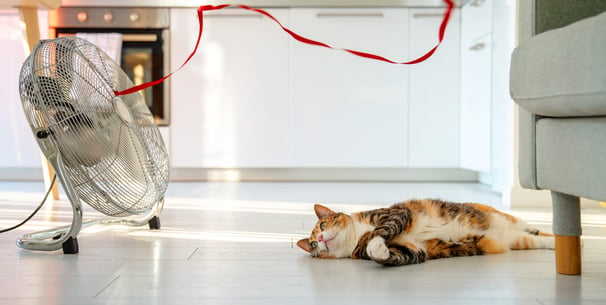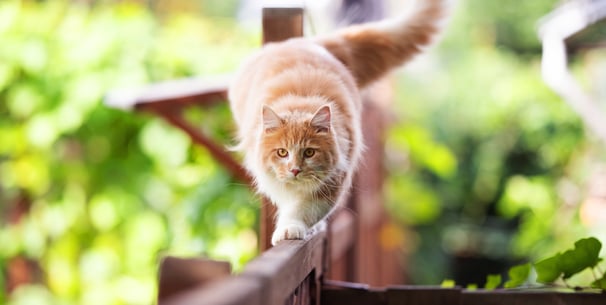Why Do Cats Wag Their Tails? - Cat Behaviour Explained
Index:



Introduction
Cats do many weird and wonderful things (see: making biscuits and being scared of cucumbers) but did you know that movement in their tails is actually one of their ways of communicating with us?
Does your cat wag their tail when lying down? How about while being petted? If so, you might be interested in reading on to learn more about tail-wagging and how it can unlock the secret to how your cat is really feeling.
Why do cats wag their tails?
Cats wag their tails for many reasons. They wag to show their frustration and unhappiness but can also wag when they’re in pain. Tail wagging can also be a sign of affection.
The direction of the tail wag and the speed at which the said tail is wagging can actually give you a huge indication of how your cat is feeling without the need for words. Pretty impressive, right?
Unlike dogs, who wag their tails for positive reasons such as feelings of happiness and excitement, a cat's tail movements represent a whole host of emotions.
Take a look at our list of different types of tail wag below:
1. The low, flicky wag



When a cat’s tail is low it’s usually a sign of distress. If your cat's tail is slow and flicking side to side, it could mean they’re scared or very unhappy. You’re more likely to see this kind of feline behaviour when you take your cat to the dreaded vet.
If they’re still doing this when you get home it's probably worth giving them some space to decompress and work it all out.
2. The swishing wag



The swishing tail wag is usually seen when cats get annoyed. If you’re being a bit of a torment and your feline friend doesn't want to play, take a look at that tail and slowly back away.
The slow swish is often a decent barometer for you to get out of the way because, quite frankly, your cat cannot be bothered. It’s basically their way of saying ‘for your own sake, back off.’
3. The quick wag
However, if you see a quick, fast-moving tail wag, your cat may be in the mood to be entertained. When cats are feeling a tad playful they start to move their tail quickly. This type of wag is often followed by a cute pounce, saucer-like pupils, and upright ears.
4. The twitchy wag



The twitchy wag is often seen when cats are concentrating on a huge task; like catching a fly, spider, or bird. Tail twitches are often accompanied by a sweet little chatter or chirp showing they’re in The Zone.
5. The snakey wag
The snakey wag sounds exactly like what it is; when cats’ tails turn into something of a rattlesnake. It’s a very cute cat behaviour and means that they’re super excited to see you.
They also do this when they’re ready to receive attention from humans and other cats followed by purrs and happy meows.
6. The wrapping tail wag



For people with aloof cats, the wrapping tail wag can be a rare sight to behold. It means that your cat wants affection from you.
If your furry friend is dishing out the love they may try and wrap their tail around your hand, legs, arms, and even your neck!
However, this type of tail behaviour is not witnessed by most cat owners as cats prefer to display their love via headbutts and rubs.
7. The fluffy tail wag



Arched back and puffed up tail? That’s one scaredy cat. When confronted by a predator (or the hoover) cats fluff up to make themselves seem bigger.
Whilst a fluffed-up tail can look extremely cute, don’t touch it! Or you may have one angry kitty on your hands.
8. The sleeping wag
The sleeping wag occurs when, you guessed it, your cat is sleeping. If you talk to them when they are asleep they might respond with a tail wag.
This is just their way of showing you that they feel comfortable in your presence and will continue to snooze away.
9. The waving wag
Sadly, the waving wag can mean your cat is feeling under the weather so if it’s accompanied by unusual behaviour such as not eating or drinking - it may be worth a trip to the vet for a professional diagnosis.
Why do cats wag their tails while lying down?



There is no one reason why cats wag their tails while lying down. Usually, when cats are lying down they feel content and relaxed. A wag of the tail is typically just another way to show you that they feel happy.
However, they can also wag their tails when they feel annoyed or scared. If your cat’s tail is thumping their tail on the floor, they could be feeling very agitated by something so it’s best to stay out of their way.
Again, tail wagging of any sort can indicate pain. If you’ve noticed your cat acting out of character, a vet visit is always best. At Waggel, we offer 24/7 video vet calls to all members meaning you can get free veterinary advice from the comfort of your own home.
Why do cats purr and wag their tail?



Cats purr and wag their tails as a way to signal to you that they’re ready to play and/or receive affection! This expression of excitement generally involves a 'purr and wag' combination and is also accompanied by rubbing - your cat's way of expressing how much they truly love you.
Simply put, a purr and tail wag shows that your cat is living their best life and feeling like their happiest feline self. It’s also a huge indication that you’re potentially the best cat owner in the world. Go you.
Why do cats wag their tail while sleeping?
As mentioned above, cats wag their tails while sleeping when they feel relaxed and comfortable. If a cat wags their tail when they’re sleeping, they want you to know that your presence isn’t deemed a threat to them.
Wagging tails in the land of nod typically occur if you talk to your cat or are close by them as they snooze. It’s their way of continuing to communicate even whilst they’re off catching those sweet zzzzzzs.
Tail wagging when asleep is basically your cat’s way of telling you that they can hear you, they’re just choosing to ignore you - in true cat fashion.
Why do cats wag their tails in your face?
Many cat owners can confess they’ve been hit in the face with a tail from time to time. Whilst you may think nothing of it, it can actually mean lots of different things.
Some cats wag their tails in faces to mark territory, though this is usually more of a slap. Most of the time, a wag in the face is accidental and occurs when your cat is just a bit too close but feels safe in your presence.
However, it can also be a sign of irritation or overstimulation. Cats have six unique muscles in their tails and they know how to use them. If you’re getting too close and invading your cat’s personal space, a bop on the head with their tail might be just the thing to get you to back off.
On the other hand, cats do things because they’re fun. So wagging their tail in your face might be a source of entertainment for them because they like you a lot - you wouldn’t want to stand in the way of that, right?
Conclusion
Our cat friends communicate with us, and each other, through a variety of different body language cues and movements. One excellent indicator of this communication style is through wagging their tails.
A cat's tail position can mean many different things and is an expression of a wide array of emotions. Your cat might be trying to tell you that they’re happy, excited, bored, frustrated, sad, or even in pain. For example, tail thrashing is a good indicator that your cat is afraid or angry.
Therefore it’s a good idea to become familiar with the different types of tail wag and what they all mean. If you notice changes in your cat's behaviour, accompanied by low tail wags, it may be worth planning a trip to the vet or making use of Waggel’s 24/7 online vet service to provide you with reliable and professional advice at the click of a button.
Waggel Pet Insurance
Need more help? You're in luck if you're a Waggel Pet Insurance member. Along with our excellent coverage, we offer access to a 24/7 online vet to answer all your sticky questions, especially if you need grooming assistance.
Not a member? Why not get a quote now and cover your furry friend for a range of illnesses, all while enjoying our amazing perks and rewards.
Want more like this?
Get updates from us with helpful info, advice, answers to frequently asked questions and much more.
Index:
- Introduction
- Why do cats wag their tails?
- 1. The low, flicky wag
- 2. The swishing wag
- 3. The quick wag
- 4. The twitchy wag
- 5. The snakey wag
- 6. The wrapping tail wag
- 7. The fluffy tail wag
- 8. The sleeping wag
- 9. The waving wag
- Why do cats wag their tails while lying down?
- Why do cats purr and wag their tail?
- Why do cats wag their tail while sleeping?
- Why do cats wag their tails in your face?
- Conclusion
Related posts:
Get your quote
Along with our excellent coverage, we offer access to a 24/7 online vet to answer all your sticky questions.





